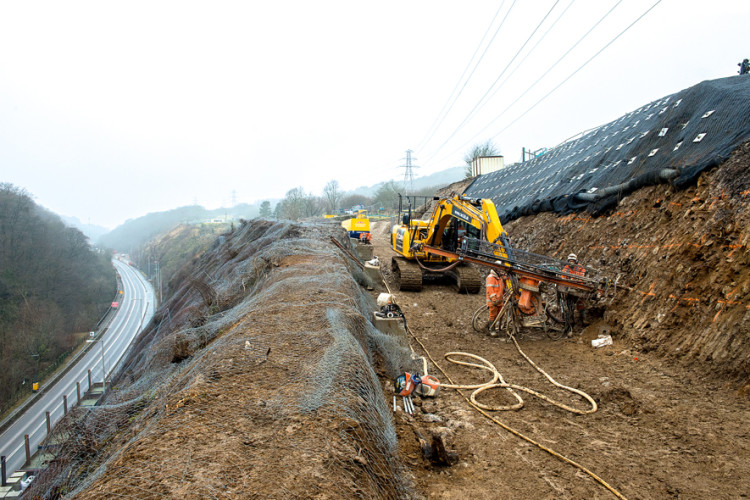The A465 Heads of the Valleys upgrade is the biggest road project in Wales and one of the biggest in the UK. Planning began in 1990; the project was given the go-ahead by the Welsh government in 1999 and work on the first of six phases began three years later.
Costain is currently working towards completion of section 2 of the scheme, a £223m project to widen the 8.1km stretch of road between Gilwern and Brynmawr to provide a dual carriageway along its entire length.
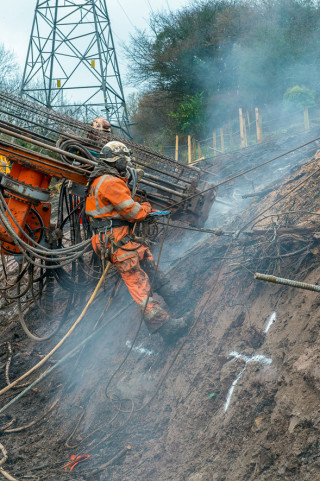
Sections 1 (Abergavenny to Gilwern), 3 (Brynmawr to Tredegar) and 4 (Tredegar to Dowlais) have been completed already. The two final phases – Section 5 (Dawlais to A470) and Section 6 (the A470 junction to Hirwaun) are due to start soon, with completion of the whole scheme scheduled for 2020.
As the popular name of the route indicates, the A465 Heads of the Valleys route cuts across the top of the south Wales valleys, between the southern fringes of the Brecon Beacons National Park and the industrial centres of Newport, Cardiff and Swansea to the south.
The road passes through some stunning scenery and while the hilly terrain is certainly dramatic, its undulating route has called for extensive earthworks with over a million tonnes of material excavated to create numerous cuttings and embankments.
In order to widen the road it has been necessary in several locations to cut into the adjacent hillside, significantly steepening the road boundary which then needs reinforcement to stabilise the ground and remove the risk of collapse.
The company tasked with stabilising these slopes is Derbyshire-based CAN Geotechnical, a specialist in the installation of ground anchors, soil nails and debris netting.
“We’ve worked on many major civil engineering projects, but this is our largest geotechnical job to date,” says project manager Mike Yaxley. Not only is the company installing over 11,000 soil nails (drilling an estimated 45 miles of holes) but the ground conditions are so variable across the 8km site that numerous different methods are required and considerable flexibility is necessary in their deployment.
CAN has installed not only soil nails, but also rock bolts, sprayed concrete, wire-basket gabions, erosion matting and rockfall netting according to the composition and stability of the ground. Where the road needs to be built outwards into the valley, the company has also stabilised the cut slope to provide temporary and permanent stability to the road.
“The soil varies a lot,” says Yaxley. “There’s lots of made ground, a lot of clay and boulders and different types of rock, ranging from mudstone and soft sandstone to very solid limestone,” he explains.
“On most jobs we’d normally have just one drill rig on site, with just one type of drill. But here we have lots of rigs and different types of drill,” adds Yaxley. At the time of writing, CAN had five rigs working of different locations along the route, but Yaxley says it has had as many as nine machines working on the project at once.
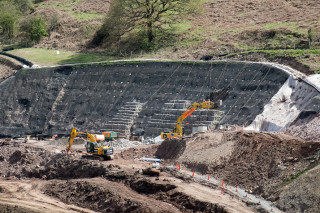
Most of the drilling is done with a hydraulic drilling attachment mounted on an excavator boom. In most cases, the excavator works downwards from the top of the slope as the roadside is progressively cut back by earthworks contractor Walters. Where access if more difficult, or an existing cliff-face needs to be stabilised, CAN uses a bespoke A-frame cradle, suspended on tirfor winches from above, to carry the drilling attachment.
CAN has employed self-drilling nails in diameters from 76mm to 150mm as well as solid anchors grouted into holes drilled into the solid rock using down-the-hole hammer techniques. The variability of the ground conditions means that grouting can literally be a hit-and-miss affair.
“We often find we’re hitting loose material or voids and then not getting any grout return,” says Yaxley. A blind hole will quickly fill with grout, but a hole that penetrates a void can swallow a lot of grout before there’s enough to cement the anchor in place.
“We’ve pumped up to three-quarters of a tonne of grout into a hole and still not had a return,” says Yaxley. Anchors grouted into ‘problem’ holes are always tested with a hydraulic jack once the grout has cured to full strength.
Even when the grouting goes smoothly, a proportion of the anchors are always tested to ascertain the strength, which varies according to the type and condition of the ground. “On each location we install four or five anchors and test all of them. That allows us to calculate the average pull-out strength for the site,” explains Yaxley.
On rocky embankments, where the risk is less from landslip and more likely from loose rock falling onto the road below, CAN
installs steel mesh debris netting. Here, anchors are driven into the rockface at intervals (typically 1m-2m centres) before the steel mesh is unrolled from the top of the slope.
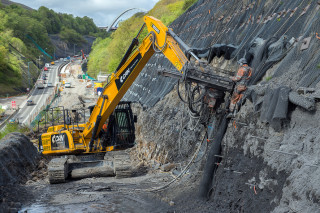
CAN has also provided temporary works to stabilise the ground and protect other workers during construction activities. This has included the installation of a 230 metre-long cantilever catch fence, rated at 1,000kJ, that was installed to prevent rockfall onto the A465 below. CAN has also installed a number of other catch fences and temporary netting to prevent rockfall onto the road. Small landslides have occurred during periods of wet weather and CAN has been quick to stabilise these areas so that works can advance.

While CAN has provided both permanent and temporary solutions to stabilise steep inclines along the 8.1km route, several of the locations where the ground slopes away steeply below the carriageway have required more extensive strengthening.
Here, Phi Group – a subsidiary of piling specialist Keller – has employed its Textomur reinforcing system to construct retaining walls and support the loadings of the carriageway above. Textomur is a cost-effective reinforced soil method that is often used to strengthen steep embankments, especially on sites where levels are being raised.
In contrast to CAN’s contribution, which is mainly about stabilising existing ground, the Textomur design is intended primarily to support made ground and is especially useful if the re-use of site-won material is being considered.
It consists of horizontal geogrids or geotextiles installed in several layers, typically at 600mm vertical centres, within compacted cohesive or granular fill material. The facing to the slopes is formed using a steel mesh ‘formwork’ backed by a geosynthetic facing fabric which retains a layer of topsoil immediately behind the face. This is typically installed at an angle of 60o – 70o to the horizontal.
On this project, Phi Group has chosen Maccaferri’s Paragrid, a polyethylene/polyester composite grid, to provide the geosynthetic layer, with locally-sourced stone compacted in layers around the Paragrid to form the reinforced soil mass.
Although their functions are complementary and overlap to some extent, CAN and Phi Group have surprisingly little to do with each other on site, says Mike Yaxley. “We come in and stabilise the ground before Phi arrives on site.” After the site has been excavated, CAN will nail the steep sloping face of the excavation to stabilise it prior to Phi Group installing the Textomur bench and retaining wall.
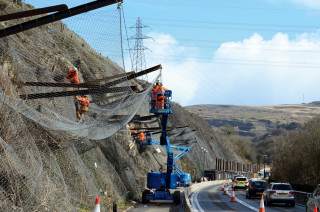
Facts & Figures
• While CAN has worked on several major projects, the A465 upgrade is its biggest soil-nailing contract to date:
• So far, CAN has installed over 10,800 soil nails and rock bolts - a total of 44 miles drilled.
• CAN has installed more than 36,000m2 of rockfall netting (an area equivalent to five football pitches).
• Total quantity of sprayed concrete: 250 tonnes.
• Total quantity of grout: 1,000,000 litres.
The Heads of the Valleys improvement scheme
Almost since the day the A465 opened in the 1960s there has been talk of improvements to the route. But nothing was done until 1990 when a traffic study was undertaken. In 1995 the Secretary of State for Wales announced the preferred route and the scheme was given the final go-ahead in 1999.
The A465 is being upgraded to a dual carriageway in six phases along its entire route. Section 4 (Tredegar to Dowlais) was completed in 2004, followed by Section 1 (Abergavenny to Gilwern) in 2008 and Section 3 (Brynmawr to Tredegar) in 2015.
Main contractor Costain is now approaching the latter stages of Section 2, a £233m project to dual the 8.1km stretch of road between Gilwern and Brynmawr.
Section 2 includes some of the project’s most mountainous terrain and includes the Clydach Gorge where the road is bounded on one side by a 30m-high rockface and on the other by a 20m drop down to the River Clydach. The road also climbs steeply from Gilwern to Brynmawr, 270m above.
The three-and-a-half-year project includes 16 major structures, including a 100m-span arched bridge over the gorge, and entails around 1.1 million cubic metres of earthworks, with all the excavated material reused for landscaping, fill and embankments.
The project team for the design and build of Section 2 consists of Costain, Atkins, CH2M (now part of Jacobs) and environmental consultant RPS. Earthmoving contractor is the Walters Group. Completion is scheduled for 2019.
This article was first published in the September 2018 issue of The Construction Index magazine
UK readers can have their own copy of the magazine, in real paper, posted through their letterbox each month by taking out an annual subscription for just £50 a year. Click for details.
Got a story? Email news@theconstructionindex.co.uk

